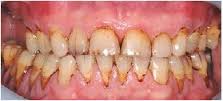You may have noticed that teeth can stain or change colour over time, either in your own teeth or others’. Whether it is a yellow pigment or a dark brown shade, any teeth discolouration can affect a bright smile. So what discolours teeth? And how can you prevent it from happening to you?

The Root of the Problem
There are two types of teeth discolouration: external and internal. External tooth discolouration is staining of the outer enamel of the teeth, and this is due to the combination of three things:
- Chromogens which are highly pigmented compounds;
- Tannins which are compounds found in plants that enable staining products to stick to enamel;
- Acids which weaken the enamel so teeth are easier to stain.
When you ingest foods or drinks that are high in one or a combination of the above three things (such as drinking tea and coffee, wine, soft drinks, acidic fruits, or even smoking tobacco), the enamel of your teeth will be highly susceptible to discolouration.

Internal tooth discolouration is the staining of the dentin inside teeth and there can be various reasons for this:
- Trauma to the teeth leading to pulpal necrosis (death of the nerve inside the tooth) or internal bleeding (like a bruise inside the tooth that does not go away);
- Ingesting particular medications that have a side effect of staining teeth dentin (especially antibiotics such as tetracycline and doxycycline);
- The use of amalgam fillings when the dentist restores your teeth (amalgam restorations are quite dark in colour and this can show through your teeth);
- Consuming excessive amounts of fluoride during early childhood (fluoride is great for teeth but too much of anything can lead to undesirable results);
- The natural process of aging means that as the years wear on, the outer enamel wears down and allows the naturally yellow tinge of dentin to show through.

What Can You Do About It?
The treatment options depend on what type of discolouration you are experiencing. If it is external discolouration of your teeth enamel caused by food, drinks, or smoking, you can stop or reduce the amount you are consuming.
Also, prevention through regular brushing and flossing is the most cost effective way to ensure a bright smile – just brush or rinse your mouth after every meal and you’re on your way to maintaining the pearly whites.

However, if external stains are a bit too much for the toothbrush to handle, in which case your dentist can help you out with a professional scale and clean or by bleaching your teeth. As you would be in the care of your dentist, he or she will be able to bleach your teeth at a higher dosage in a shorter time frame than your average over-the-counter take home bleaching kits.
If it is internal teeth discolouration, things get a bit trickier. With pulpal or nerve necrosis due to a traumatic incident (this often happens when someone’s teeth get knocked such as during a sporting event), this is best treated with root canal treatment followed by internal bleaching. Alternatively, a crown or veneer could be the dentist’s recommendation to cover the discoloured teeth, particularly when bleaching will not help with internal stains caused by antibiotics. If you are a mother, keep in mind that using tetracycline antibiotics during your second half of pregnancy will affect your child’s teeth. And if your child is 8 years old or younger, this will also affect their permanent teeth colour.

If you are concerned about how amalgam fillings will impact the colour of your teeth, you can ask your dentist to restore your teeth with composite resin fillings instead of amalgam fillings.
Consuming excessive amounts of fluoride during early childhood can be prevented with parents being aware of the correct amount to give their children. Unfortunately, there is no cure for aging, but restorative treatment options such as crowns or veneers are possibilities.

Keep on smiling with a bright healthy smile, and if you don’t know how to get your teeth looking nice and white again, your dentist will be able to tell you exactly how to regain that.
